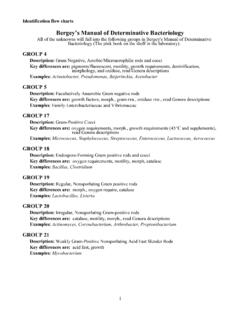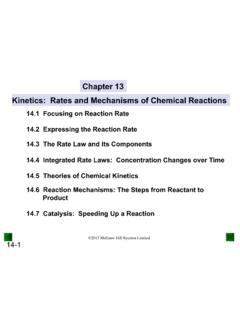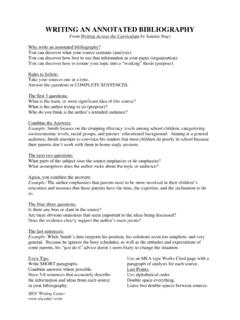Transcription of Lectures on Differential Geometry
1 Lectures on Differential GeometryWulfRossmann000 (Updated October 2003)2To the studentThis is a collection of lecture notes which I put together while teaching courseson manifolds, tensor analysis, and differential Geometry . I offer them to you inthe hope that they may help you, and to complement the Lectures . The styleis uneven, sometimes pedantic, sometimes sloppy, sometimes telegram style,sometimes long winded, etc., depending on my mood when I was writing thoseparticular lines. At least this set of notes is visibly finite. There are a greatmany meticulous and voluminous books written on the subject of these notesand there is no point of writing another one of that kind.
2 After all, we aretalking about some fairly old mathematics, still useful, even essential, as a tooland still fun, I think, at least some parts of comment about the nature of the subject (elementary differential geometryand tensor calculus) as presented in these notes. I see it as a natural continuationof analytic Geometry and calculus. It provides some basic equipment, which isindispensable in many areas of mathematics ( analysis, topology, differentialequations, Lie groups) and physics ( classical mechanics, general relativity,all kinds of field theories).If you want to have another view of the subject you should by all means lookaround, but I suggest that you don t attempt to use other sources to straightenout problems you might have with the material here.
3 It would probably takeyou much longer to familiarize yourself sufficiently with another book to getyour question answered than to work out your problem on your own. Eventhough these notes are brief, they should be understandable to anybody whoknows calculus and linear algebra to the extent usually seen in second-yearcourses. There are no difficult theorems here; it is rather a matter of providinga framework for various known concepts and theorems in a more general andmore natural setting. Unfortunately, this requires a large number of definitionsand constructions which may be hard to swallow and even harder to digest.(In this subject the definitions are much harder than the theorems.)
4 In anycase, just by randomly leafing through the notes you will see many complicatedlooking expressions. Don t be intimidated: this stuff is easy. When you lookedat a calculus text for the first time in your life it probably looked complicatedas well. Perhaps it will help to contemplate this piece of advice by HermannWeyl from his classicRaum Zeit Materie of1918(my translation).Many willbe horrified by the flood of formulas and indices which here drown the main idea34of differential Geometry (in spite of the author s honest effort for conceptualclarity). It is certainly regrettable that we have to enter into purely formalmatters in such detail and give them so much space; but this cannot be as we have to spend laborious hours learning language and writing to freelyexpress our thoughts, so the only way that we can lessen the burden of formulashere is to master the tool of tensor analysis to such a degree that we can turnto the real problems that concern us without being bothered by formal chart1.
5 Review of linear algebra and calculus Manifolds: definitions and examples Vectors and differentials Submanifolds Riemann metrics Tensors 752. Connections and curvature3. Calculus on Connections Geodesics Riemann curvature Gauss curvature Levi-Civita s connection Curvature identities Differential forms Differential calculus Integral calculus Lie derivatives 1554. Special General Relativity The Schwarzschild metric The rotation group SO(3) Cartan s mobile frame Weyl s gauge theory paper of 1929 199 Chapter 3 is independent of chapter 2 and is used only in section Review of linear algebra and calculus.
6 Manifolds: definitions and examples .. Vectors and differentials .. Submanifolds .. Riemann metrics .. Tensors .. 752 Connections and Connections .. Geodesics .. Riemann curvature .. Gauss curvature .. Levi-Civita s connection .. Curvature identities .. 1303 Calculus on Differential forms .. Differential calculus .. Integral calculus .. Lie derivatives .. 1554 Special General Relativity .. The Schwarzschild metric .. The rotation group SO(3) .. Cartan s mobile frame .. Weyl s gauge theory paper of 1929 .. 199 Time chart217 annotated bibliography219 Index22078 CONTENTSC hapter Review of linear algebra and calculusA.
7 Linear algebra. A(real) vector spaceis a setVtogether with two opera-tions, vector additionu+v(u,v V) and scalar multiplication v( R,v V). These operations have to satisfy those axioms you know (and can findspelled out in your linear algebra text). Example:Rnis the vector space of realn tuples (x1, ,xn),xi Rwith componentwise vector addition and scalarmultiplication. The basic fact is thatevery vector space has a basis, meaninga set of vectors{vi}so that any other vectorvcan be writtenuniquelyas alinear combination iviofvi s. We shall always assume that our spaceVisfinite dimensional, which means that it admits a finite basis, consisting of saynelements.
8 It that case any other basis has alsonelements andnis calledthedimensionofV. For example,Rncomes equipped with astandard basise1, ,encharacterized by the property that (x1, ,xn) =x1e1+ + may say that we can identify VwithRnafter we fix an ordered basis{v1, ,vn}, since thex Vcorrespond one to one to theirn tuples of com-ponents (x1, ,xn) R. But note(!): this identification depends on the choiceof the basis{vi}which becomes the standard basis{ei}ofRn. The indiceson iandviare placed the way they are with the following rule in Summation convention. Any index occurring twice, once up, oncedown, is summed over. For examplexiei= ixiei=x1e1+ +xnen.
9 Wemay still keep the s if we want to remind ourselves of the transformation(orlinear map)A:V Wbetween two vector spacesis a map which respects the two operations, (u+v) =Au+AvandA( v) = Av. One often writesAvinstead ofA(v) for linear maps. In terms of a basis{v1, ,vn}forVand{w1, ,wm}forWthis implies thatAv= ij iajivjifv= i ivifor some indexed system of scalars (aji) called thematrix ofAwith respect to the bases{vi},{wj}. With the summation convention theequationw=Avbecomes j=aji i. Example: the matrix of the identity910 CHAPTER 1. MANIFOLDS transformation 1 :V V(with respect to any basis) is the Kronecker delta ijdefined by ij={1 ifi=j0 ifi6=jTheinverse(if it exists) of a linear transformationAwith matrix (aji) is thelinear transformationBwhose matrix (bji) satisfiesaikbkj= ijIfA:V Vis a linear transformation ofVinto itself, then thedeterminantofAis defined by the formuladet(A) = i1 inai11 ainn(1)where i1 in= 1 is the sign of the permutation (i1, ,in) of (1, ,n).}
10 Thisseems to depend on the basis we use to writeAas a matrix (aij), but in fact itdoesn t. Recall the following :V Vis invertible if and only ifdet(A)6= is a formula forA 1(Cramer s Formula) which says thatA 1=1det(A) A, aji= ( 1)i+jdet[alk|kl6=ji] .Theijentry ajiof Ais called thejicofactor ofA, as you can look up in yourlinear algebra text. This formula is rarely practical for the actual calculation ofA 1for a particularA, but it is sometimes useful for theoretical considerationsor for matrices with variable a linear transformationA:V Wis the dimension of the imageofA, ofim(A) ={w W:w=Avfor somev V}.This rank is equal to maximal number of linearly independent columns of thematrix (aij), and equals maximal number of linearly independent rows as linear mapA:V Wissurjective( onto) iff1rank(A) =mandinjective( one to one) iff rank(A) =n.








